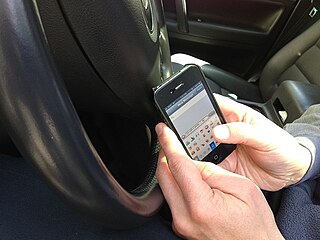
The Emergency Broadcast System (EBS), sometimes called the Emergency Action Notification System (EANS), was an emergency warning system used in the United States. It was the most commonly used, along with the Emergency Override system. It replaced the previous CONELRAD system and was used from 1963 to 1997, at which point it was replaced by the Emergency Alert System.

911, sometimes written 9-1-1, is an emergency telephone number for Argentina, Canada, Dominican Republic, Jordan, Mexico, Palau, Panama, the Philippines, Sint Maarten, the United States, and Uruguay, as well as the North American Numbering Plan (NANP), one of eight N11 codes. Like other emergency numbers around the world, this number is only intended for use in emergency circumstances. Using it for any other purpose is a crime in most jurisdictions. Penalties for abuse or misuse of 911 can range from probation or community service to fines and jail time. Offenders can also be ordered to undergo counseling and have their use of telephones restricted or suspended for a period time as a condition of probation.
Enhanced 911 is a system used in North America to automatically provide the caller's location to 911 dispatchers. 911 is the universal emergency telephone number in the region. In the European Union, a similar system exists known as E112 and known as eCall when called by a vehicle.

An emergency telephone number is a number that allows a caller to contact local emergency services for assistance. The emergency number differs from country to country; it is typically a three-digit number so that it can be easily remembered and dialed quickly. Some countries have a different emergency number for each of the different emergency services; these often differ only by the last digit.

The Emergency Alert System (EAS) is a national warning system in the United States designed to allow authorized officials to broadcast emergency alerts and warning messages to the public via cable, satellite and broadcast television and both AM, FM and satellite radio. Informally, Emergency Alert System is sometimes conflated with its mobile phone counterpart Wireless Emergency Alerts (WEA), a different but related system. However, both the EAS and WEA, among other systems, are coordinated under the Integrated Public Alert and Warning System (IPAWS). The EAS, and more broadly IPAWS, allows federal, state, and local authorities to efficiently broadcast emergency alert and warning messages across multiple channels. The EAS became operational on January 1, 1997, after being approved by the Federal Communications Commission (FCC) in November 1994, replacing the Emergency Broadcast System (EBS), and largely supplanted Local Access Alert systems, though Local Access Alert systems are still used from time to time. Its main improvement over the EBS, and perhaps its most distinctive feature, is its application of a digitally encoded audio signal known as Specific Area Message Encoding (SAME), which is responsible for the characteristic "screeching" or "chirping" sounds at the start and end of each message. The first signal is the "header" which encodes, among other information, the alert type and locations, or the specific area that should receive the message. The last short burst marks the end-of-message. These signals are read by specialized encoder-decoder equipment. This design allows for automated station-to-station relay of alerts to only the area the alert was intended for.

A telecommunications relay service, also known as TRS, relay service, or IP-relay, or Web-based relay service, is an operator service that allows people who are deaf, hard of hearing, deafblind, or have a speech disorder to place calls to standard telephone users via a keyboard or assistive device. Originally, relay services were designed to be connected through a TDD, teletypewriter (TTY) or other assistive telephone device. Services gradually have expanded to include almost any real-time text capable technology such as a personal computer, laptop, mobile phone, PDA, and many other devices. The first TTY was invented by deaf scientist Robert Weitbrecht in 1964. The first relay service was established in 1974 by Converse Communications of Connecticut.

5-1-1 is a transportation and traffic information telephone hotline in some regions of the United States and Canada. Travelers can dial 511, a three-digit telephone number, on landlines and most mobile phones. The number has also extended to be the default name of many state and provincial transportation department road conditions Web sites, such as Wisconsin's site. It is an example of an N11 code, part of the North American Numbering Plan.

Intrado, formerly West Corporation, is an American telecommunications company. It was purchased by private equity firm Apollo Global Management on October 11, 2017.

A public-safety answering point (PSAP), sometimes called a public-safety access point, is a type of call center where the public's telephone calls for first responders are received and handled. It takes calls from any landline, mobile phone line, or VoIP line. It can also happen that when 112 is dialed in then a logic is implemented by mobile or network operators to route the call to the nearest police station. Such call centers exist in most countries to answer calls to an emergency telephone number. Trained telephone operators are also usually responsible for dispatching these emergency services. Most PSAPs are now capable of caller location for landline calls, and many can handle mobile phone locations as well, where the mobile phone company has a handset to location system. Some can also use voice broadcasting where outgoing voice mail can be sent to many phone numbers at once, in order to alert people to a local emergency such as a chemical spill.
Abbreviated dialing is the use of a very short digit sequence to reach specific telephone numbers, such as those of public services. The purpose of such numbers is to be universal, short, and easy to remember. Typically they are two or three digits.

A video relay service (VRS), also sometimes known as a video interpreting service (VIS), is a video telecommunication service that allows deaf, hard-of-hearing, and speech-impaired (D-HOH-SI) individuals to communicate over video telephones and similar technologies with hearing people in real-time, via a sign language interpreter.

Video remote interpreting (VRI) is a videotelecommunication service that uses devices such as web cameras or videophones to provide sign language or spoken language interpreting services. This is done through a remote or offsite interpreter, in order to communicate with persons with whom there is a communication barrier. It is similar to a slightly different technology called video relay service, where the parties are each located in different places. VRI is a type of telecommunications relay service (TRS) that is not regulated by the FCC.
The Wireless Communications and Public Safety Act of 1999 is a United States federal law enacted as Public Law 106–81 of October 26, 1999. It is also known as the 911 Act. The act required the setup of enhanced 911 and mandated that 911 serve as the emergency number for non-land line phones as well. It was an amendment to the Communications Act of 1934 as amended by the Telecommunications Act of 1996.
988 is a telephone number used in some NANP countries for a suicide prevention helpline. It is known as 988 Suicide & Crisis Lifeline in the United States and as 9-8-8 Suicide Crisis Helpline in Canada.
Next Generation 9-1-1 refers to an initiative aimed at updating the 911 service infrastructure in the United States and Canada to improve public emergency communications services in a growing wireless mobile society. In addition to calling 9-1-1 from a phone, it intends to enable the public to transmit text, images, video and data to the 9-1-1 center. The initiative also envisions additional types of emergency communications and data transfer. This NG9-1-1 infrastructure is intended to replace the current services over time. The National Emergency Number Association (NENA) first identified the need for NG9-1-1 in 2000, and started development actions in 2003, and is nearing full definition and standards for NG9-1-1. Since 2006, the US Department of Transportation (DOT) in the United States and the Canadian Radio-television and Telecommunications Commission (CRTC) in Canada have been leading their respective initiatives, which include research and development projects aimed at advancing NG9-1-1. On January 24, 2013, the CRTC announced the first step toward a Canadian implementation of NG9-1-1 and, in March 2016, began a consultation with the public to discuss what services should be offered, who will play a role in offering these services and how these services should be paid for. Several US states have implemented versions of NG9-1-1, as of October 2013.

RabbitEars is a website dedicated to providing information on over-the-air digital television in the United States, its territories and protectorates, and border areas of Canada and Mexico. Aside from merely listing network affiliations and technical data, notations of stations carrying Descriptive Video Service, TVGOS, UpdateTV, Sezmi, Mobile DTV, and MediaFLO are also now covered on the site. RabbitEars also maintains a spreadsheet of current television stations.

Texting while driving, also called texting and driving, is the act of composing, sending, or reading text messages on a mobile phone while operating a motor vehicle. Texting while driving is considered extremely dangerous by many people, including authorities, and in some places has either been outlawed or restricted. As a form of distracted driving, texting while driving significantly increases the chances that a driver will be involved in a motor vehicle accident.

Wireless Emergency Alerts, is an alerting network in the United States designed to disseminate emergency alerts to mobile devices such as cell phones and pagers. Organizations are able to disseminate and coordinate emergency alerts and warning messages through WEA and other public systems by means of the Integrated Public Alert and Warning System.
An emergency communication system (ECS) is any system that is organized for the primary purpose of supporting one-way and two-way communication of emergency information between both individuals and groups of individuals. These systems are commonly designed to convey information over multiple types of devices, from signal lights to text messaging to live, streaming video, forming a unified communication system intended to optimize communications during emergencies. Contrary to emergency notification systems, which generally deliver emergency information in one direction, emergency communication systems are typically capable of both initiating and receiving information between multiple parties. These systems are often made up of both input devices, sensors, and output/communication devices. Therefore, the origination of information can occur from a variety of sources and locations, from which the system will disseminate that information to one or more target audiences.
RapidSOS is an intelligent safety platform that securely links data to 9-1-1 and first responders. It connects more than 500 million devices directly to 15,000+ first responder agencies.











